Soil Phosphorus Content, Organic Matter, and Elevation Are Key Determinants of Maize Harvest Index in Arid Regions
Abstract
1. Introduction
2. Materials and Methods
2.1. Study Sites
2.2. Study Design
2.3. Data Collection
2.3.1. Plant Sampling and Processing
2.3.2. Agronomic Management Factors
2.3.3. Climatic–Geographic Factors
2.3.4. Soil Sampling and Analysis
2.4. Calculations and Statistical Analysis
3. Results
3.1. Comparison of Productivity Parameters Among Maize Varieties with Different Maturity Periods in Arid Regions
3.2. Inter-Relationships Between Productivity Parameters in Arid Regions
3.3. Effects of Planting Density on Productivity Parameters
3.4. Determinants of Productivity Parameters Across Maize Maturity Groups
3.4.1. Correlation Heatmap Analysis of Productivity Parameters of Maize in Different Maturity Groups with Influencing Factors
3.4.2. Determinants of Maize Harvest Index in Arid Ecosystems
3.4.3. Linear Regression Analysis of the Harvest Index and Its Determinants
4. Discussion
4.1. Variation in Productivity Parameters Among Maize Maturity Groups
4.2. Density-Dependent Relationships Between Productivity Parameters in Maize
4.3. Geographic and Climatic Determinants of Harvest Index Variation
4.4. Soil Physicochemical Regulation of the Harvest Index in Maize
4.5. Study Limitations
5. Conclusions
Author Contributions
Funding
Institutional Review Board Statement
Data Availability Statement
Acknowledgments
Conflicts of Interest
References
- Huang, J.; Yu, H.; Guan, X.; Wang, G.; Guo, R. Accelerated Dryland Expansion under Climate Change. Nat. Clim. Change 2016, 6, 166–171. [Google Scholar] [CrossRef]
- Huang, J.; Li, Y.; Fu, C.; Chen, F.; Fu, Q.; Dai, A.; Shinoda, M.; Ma, Z.; Guo, W.; Li, Z.; et al. Dryland Climate Change: Recent Progress and Challenges. Rev. Geophys. 2017, 55, 719–778. [Google Scholar] [CrossRef]
- Chen, S.; Du, T.; Wang, S.; Parsons, D.; Wu, D.; Guo, X.; Li, D. Quantifying the Effects of Spatial-Temporal Variability of Soil Properties on Crop Growth in Management Zones within an Irrigated Maize Field in Northwest China. Agric. Water Manag. 2021, 244, 106535. [Google Scholar] [CrossRef]
- Donald, C.M.; Hamblin, J. The Biological Yield and Harvest Index of Cereals as Agronomic and Plant Breeding Criteria. In Advances in Agronomy; Brady, N.C., Ed.; Academic Press: Cambridge, MA, USA, 1976; Volume 28, pp. 361–405. [Google Scholar]
- Hay, R.K.M. Harvest Index: A Review of Its Use in Plant Breeding and Crop Physiology. Ann. Appl. Biol. 1995, 126, 197–216. [Google Scholar] [CrossRef]
- Ashman, T.-L.; Schoen, D.J. How Long Should Flowers Live? Nature 1994, 371, 788–791. [Google Scholar] [CrossRef]
- Weiner, J. Plant Reproductive Ecology: Patterns and Strategies; Oxford University Press: Oxford, UK, 1988; ISBN 978-0-19-506394-3. [Google Scholar]
- Johnson, J.M.-F.; Allmaras, R.R.; Reicosky, D.C. Estimating Source Carbon from Crop Residues, Roots and Rhizodeposits Using the National Grain-Yield Database. Agron. J. 2006, 98, 622–636. [Google Scholar] [CrossRef]
- Dai, J.; Bean, B.; Brown, B.; Bruening, W.; Edwards, J.; Flowers, M.; Karow, R.; Lee, C.; Morgan, G.; Ottman, M.; et al. Harvest Index and Straw Yield of Five Classes of Wheat. Biomass Bioenergy 2016, 85, 223–227. [Google Scholar] [CrossRef]
- Solomon, B.D.; Barnes, J.R.; Halvorsen, K.E. Grain and Cellulosic Ethanol: History, Economics, and Energy Policy. Biomass Bioenergy 2007, 31, 416–425. [Google Scholar] [CrossRef]
- Chen, G. Dry Matter Production and Distribution. Maize Sci. 1994, 2, 48–53. [Google Scholar]
- Brancourt-Hulmel, M.; Doussinault, G.; Lecomte, C.; Bérard, P.; Le Buanec, B.; Trottet, M. Genetic Improvement of Agronomic Traits of Winter Wheat Cultivars Released in France from 1946 to 1992. Crop Sci. 2003, 43, 37–45. [Google Scholar] [CrossRef]
- Xiao, Y.G.; Qian, Z.G.; Wu, K.; Liu, J.J.; Xia, X.C.; Ji, W.Q.; He, Z.H. Genetic Gains in Grain Yield and Physiological Traits of Winter Wheat in Shandong Province, China, from 1969 to 2006. Crop Sci. 2012, 52, 44–56. [Google Scholar] [CrossRef]
- Peng, S.; Laza, R.C.; Visperas, R.M.; Sanico, A.L.; Cassman, K.G.; Khush, G.S. Grain Yield of Rice Cultivars and Lines Developed in the Philippines since 1966. Crop Sci. 2000, 40, 307–314. [Google Scholar] [CrossRef]
- Duvick, D.N. The Contribution of Breeding to Yield Advances in Maize (Zea mays L.). In Advances in Agronomy; Academic Press: Cambridge, MA, USA, 2005; Volume 86, pp. 83–145. [Google Scholar]
- Li, J.; Xie, R.Z.; Wang, K.R.; Ming, B.; Guo, Y.Q.; Zhang, G.Q.; Li, S.K. Variations in Maize Dry Matter, Harvest Index, and Grain Yield with Plant Density. Agron. J. 2015, 107, 829–834. [Google Scholar] [CrossRef]
- Meghji, M.R.; Dudley, J.W.; Lambert, R.J.; Sprague, G.F. Inbreeding Depression, Inbred and Hybrid Grain Yields, and Other Traits of Maize Genotypes Representing Three Eras. Crop Sci. 1984, 24, 545–549. [Google Scholar] [CrossRef]
- Tollenaar, M. Genetic Improvement in Grain Yield of Commercial Maize Hybrids Grown in Ontario from 1959 to 1988. Crop Sci. 1989, 29, 1365–1371. [Google Scholar] [CrossRef]
- Echarte, L.; Andrade, F.H. Harvest Index Stability of Argentinean Maize Hybrids Released between 1965 and 1993. Field Crops Res. 2003, 82, 1–12. [Google Scholar] [CrossRef]
- Hou, P.; Gao, Q.; Xie, R.; Li, S.; Meng, Q.; Kirkby, E.A.; Römheld, V.; Müller, T.; Zhang, F.; Cui, Z.; et al. Grain Yields in Relation to N Requirement: Optimizing Nitrogen Management for Spring Maize Grown in China. Field Crops Res. 2012, 129, 1–6. [Google Scholar] [CrossRef]
- Ruiz, A.; Trifunovic, S.; Eudy, D.M.; Sciarresi, C.S.; Baum, M.; Danalatos, G.J.N.; Elli, E.F.; Kalogeropoulos, G.; King, K.; dos Santos, C.; et al. Harvest Index Has Increased over the Last 50 Years of Maize Breeding. Field Crops Res. 2023, 300, 108991. [Google Scholar] [CrossRef]
- Sun, J.; Zhan, T.; Liu, M.; Zhang, Z.; Wang, Y.; Liu, S.; Wu, G.; Liu, G.; Tsunekawa, A. Verification of the Biomass Transfer Hypothesis under Moderate Grazing across the Tibetan Plateau: A Meta-Analysis. Plant Soil 2021, 458, 139–150. [Google Scholar] [CrossRef]
- Zhang, Y.; Yang, G.-S.; Shi, F.-X.; Mao, R. Biomass Allocation between Leaf and Stem Regulates Community-Level Plant Nutrient Resorption Efficiency Response to Nitrogen and Phosphorus Additions in a Temperate Wetland of Northeast China. J. Plant Ecol. 2021, 14, 58–66. [Google Scholar] [CrossRef]
- Zhu, Y.-H.; Weiner, J.; Jin, Y.; Yu, M.-X.; Li, F.-M. Biomass Allocation Responses to Root Interactions in Wheat Cultivars Support Predictions of Crop Evolutionary Ecology Theory. Front. Plant Sci. 2022, 13, 858636. [Google Scholar] [CrossRef] [PubMed]
- Golan, G.; Weiner, J.; Zhao, Y.; Schnurbusch, T. Agroecological Genetics of Biomass Allocation in Wheat Uncovers Genotype Interactions with Canopy Shade and Plant Size. New Phytol. 2024, 242, 107–120. [Google Scholar] [CrossRef] [PubMed]
- Li, G.; Si, M.; Zhang, C.; Shen, Z.; Wang, S.; Shao, J. Responses of Plant Biomass and Biomass Allocation to Experimental Drought: A Global Phylogenetic Meta-Analysis. Agric. For. Meteorol. 2024, 347, 109917. [Google Scholar] [CrossRef]
- Zhou, L.; Zhou, X.; He, Y.; Fu, Y.; Du, Z.; Lu, M.; Sun, X.; Li, C.; Lu, C.; Liu, R.; et al. Global Systematic Review with Meta-Analysis Shows That Warming Effects on Terrestrial Plant Biomass Allocation Are Influenced by Precipitation and Mycorrhizal Association. Nat. Commun. 2022, 13, 4914. [Google Scholar] [CrossRef]
- Zhou, L.; Hong, Y.; Li, C.; Lu, C.; He, Y.; Shao, J.; Sun, X.; Wang, C.; Liu, R.; Liu, H.; et al. Responses of Biomass Allocation to Multi-Factor Global Change: A Global Synthesis. Agric. Ecosyst. Environ. 2020, 304, 107115. [Google Scholar] [CrossRef]
- Edmeades, G.O.; Bolaños, J.; Chapman, S.C.; Lafitte, H.R.; Bänziger, M. Selection Improves Drought Tolerance in Tropical Maize Populations: I. Gains in Biomass, Grain Yield, and Harvest Index. Crop Sci. 1999, 39, 1306–1315. [Google Scholar] [CrossRef]
- Hou, P.; Liu, Y.; Xie, R.; Ming, B.; Ma, D.; Li, S.; Mei, X. Temporal and Spatial Variation in Accumulated Temperature Requirements of Maize. Field Crops Res. 2014, 158, 55–64. [Google Scholar] [CrossRef]
- Liu, G.; Hou, P.; Xie, R.; Ming, B.; Wang, K.; Xu, W.; Liu, W.; Yang, Y.; Li, S. Canopy Characteristics of High-Yield Maize with Yield Potential of 22.5 Mg Ha−1. Field Crops Res. 2017, 213, 221–230. [Google Scholar] [CrossRef]
- Hou, P.; Liu, Y.; Liu, W.; Liu, G.; Xie, R.; Wang, K.; Ming, B.; Wang, Y.; Zhao, R.; Zhang, W.; et al. How to Increase Maize Production without Extra Nitrogen Input. Resour. Conserv. Recycl. 2020, 160, 104913. [Google Scholar] [CrossRef]
- Liu, Y.; Xie, R.; Hou, P.; Li, S.; Zhang, H.; Ming, B.; Long, H.; Liang, S. Phenological Responses of Maize to Changes in Environment When Grown at Different Latitudes in China. Field Crops Res. 2013, 144, 192–199. [Google Scholar] [CrossRef]
- Xu, W.; Liu, C.; Wang, K.; Xie, R.; Ming, B.; Wang, Y.; Zhang, G.; Liu, G.; Zhao, R.; Fan, P.; et al. Adjusting Maize Plant Density to Different Climatic Conditions across a Large Longitudinal Distance in China. Field Crops Res. 2017, 212, 126–134. [Google Scholar] [CrossRef]
- Liu, B.; Chen, X.; Meng, Q.; Yang, H.; van Wart, J. Estimating Maize Yield Potential and Yield Gap with Agro-Climatic Zones in China—Distinguish Irrigated and Rainfed Conditions. Agric. For. Meteorol. 2017, 239, 108–117. [Google Scholar] [CrossRef]
- Zhou, B.; Yue, Y.; Sun, X.; Wang, X.; Wang, Z.; Ma, W.; Zhao, M. Maize Grain Yield and Dry Matter Production Responses to Variations in Weather Conditions. Agron. J. 2016, 108, 196–204. [Google Scholar] [CrossRef]
- Liu, Y.; Hou, P.; Xie, R.; Li, S.; Zhang, H.; Ming, B.; Ma, D.; Liang, S. Spatial Adaptabilities of Spring Maize to Variation of Climatic Conditions. Crop Sci. 2013, 53, 1693–1703. [Google Scholar] [CrossRef]
- Hao, B.; Xue, Q.; Marek, T.H.; Jessup, K.E.; Hou, X.; Xu, W.; Bynum, E.D.; Bean, B.W. Radiation-Use Efficiency, Biomass Production, and Grain Yield in Two Maize Hybrids Differing in Drought Tolerance. J. Agron. Crop Sci. 2016, 202, 269–280. [Google Scholar] [CrossRef]
- Sinclair, T.R. Historical Changes in Harvest Index and Crop Nitrogen Accumulation. Crop Sci. 1998, 38, 638–643. [Google Scholar] [CrossRef]
- Amanullah; Iqbal, A.; Irfanullah; Hidayat, Z. Potassium Management for Improving Growth and Grain Yield of Maize (Zea mays L.) under Moisture Stress Condition. Sci. Rep. 2016, 6, 34627. [Google Scholar] [CrossRef]
- Jaynes, D.B.; Colvin, T.S.; Kaspar, T.C. Identifying Potential Soybean Management Zones from Multi-Year Yield Data. Comput. Electron. Agric. 2005, 46, 309–327. [Google Scholar] [CrossRef]
- Robertson, M.; Isbister, B.; Maling, I.; Oliver, Y.; Wong, M.; Adams, M.; Bowden, B.; Tozer, P. Opportunities and Constraints for Managing Within-Field Spatial Variability in Western Australian Grain Production. Field Crops Res. 2007, 104, 60–67. [Google Scholar] [CrossRef]
- Jan, B.; Anwar Bhat, M.; Bhat, T.A.; Yaqoob, M.; Nazir, A.; Ashraf Bhat, M.; Mir, A.H.; Wani, F.J.; Kumar Singh, J.; Kumar, R.; et al. Evaluation of Seedling Age and Nutrient Sources on Phenology, Yield and Agrometeorological Indices for Sweet Corn (Zea mays saccharata L.). Saudi J. Biol. Sci. 2022, 29, 735–742. [Google Scholar] [CrossRef]
- Li, N.; Lin, H.; Wang, T.; Li, Y.; Liu, Y.; Chen, X.; Hu, X. Impact of Climate Change on Cotton Growth and Yields in Xinjiang, China. Field Crops Res. 2020, 247, 107590. [Google Scholar] [CrossRef]
- Jiapaer, G.; Liang, S.; Yi, Q.; Liu, J. Vegetation Dynamics and Responses to Recent Climate Change in Xinjiang Using Leaf Area Index as an Indicator. Ecol. Indic. 2015, 58, 64–76. [Google Scholar] [CrossRef]
- Edwards, J.T.; Purcell, L.C.; Vories, E.D. Light Interception and Yield Potential of Short-Season Maize (Zea mays L.) Hybrids in the Midsouth. Agron. J. 2005, 97, 225–234. [Google Scholar] [CrossRef]
- Ke, F.; Ma, X. Responses of Maize Hybrids with Contrasting Maturity to Planting Date in Northeast China. Sci. Rep. 2021, 11, 15776. [Google Scholar] [CrossRef]
- Shi, Z.; Yang, C.; Li, F.; Wang, Z.; Lv, X.; Wang, H.; Zhu, M. Analysis of Reasons for Low Yield among Late-Maturing Maize Varieties in Liaoning Province. Seed 2012, 31, 73–76. [Google Scholar] [CrossRef]
- Yao, Y.; Wang, X.; Yu, B.; Feng, G.; Bai, X.; Chen, Z. Yield Comparison of Maize Hybrids with Different Maturity in Three Locations of Liaoning Province. China Seed Ind. 2012, 10, 57–59. [Google Scholar] [CrossRef]
- Chen, L.; Shi, Z.; Li, F.; Wang, Z.; Wang, H.; Lv, X. Comparison of Yield and Related Traits of Maize Varieties with Different Maturity Periods in Liaoning Province. Seed 2010, 29, 68–71. [Google Scholar] [CrossRef]
- Di Matteo, J.A.; Ferreyra, J.M.; Cerrudo, A.A.; Echarte, L.; Andrade, F.H. Yield Potential and Yield Stability of Argentine Maize Hybrids over 45 Years of Breeding. Field Crops Res. 2016, 197, 107–116. [Google Scholar] [CrossRef]
- Hu, C.; Dong, S.; Wang, K.; Sun, Q. Evolution of Maize Cultivars in Different Ages in China: II. Evolution of Material Production Characteristics. Maize Sci. 1998, 50–54. [Google Scholar]
- Russell, W.A. Evaluations for Plant, Ear, and Grain Traits of Maize Cultivars Representing Seven Eras of Breeding. Maydica 1985, 30, 85–96. [Google Scholar]
- Curin, F.; Severini, A.D.; González, F.G.; Otegui, M.E. Water and Radiation Use Efficiencies in Maize: Breeding Effects on Single-Cross Argentine Hybrids Released between 1980 and 2012. Field Crops Res. 2020, 246, 107683. [Google Scholar] [CrossRef]
- Poorter, H.; Niinemets, Ü.; Ntagkas, N.; Siebenkäs, A.; Mäenpää, M.; Matsubara, S.; Pons, T.L. A Meta-Analysis of Plant Responses to Light Intensity for 70 Traits Ranging from Molecules to Whole Plant Performance. New Phytol. 2019, 223, 1073–1105. [Google Scholar] [CrossRef] [PubMed]
- Postma, J.A.; Hecht, V.L.; Hikosaka, K.; Nord, E.A.; Pons, T.L.; Poorter, H. Dividing the Pie: A Quantitative Review on Plant Density Responses. Plant Cell Environ. 2021, 44, 1072–1094. [Google Scholar] [CrossRef] [PubMed]
- Farnsworth, A.; Lunt, D.J.; Robinson, S.A.; Valdes, P.J.; Roberts, W.H.G.; Clift, P.D.; Markwick, P.; Su, T.; Wrobel, N.; Bragg, F.; et al. Past East Asian Monsoon Evolution Controlled by Paleogeography, Not CO2. Sci. Adv. 2019, 5, eaax1697. [Google Scholar] [CrossRef]
- Zhang, R.; Jiang, D.; Ramstein, G.; Zhang, Z.; Lippert, P.C.; Yu, E. Changes in Tibetan Plateau Latitude as an Important Factor for Understanding East Asian Climate since the Eocene: A Modeling Study. Earth Planet. Sci. Lett. 2018, 484, 295–308. [Google Scholar] [CrossRef]
- Zhang, R.; Jiang, D.; Zhang, Z.; Cheng, Z.; Zhang, Q. Comparison of the Climate Effects of Surface Uplifts from the Northern Tibetan Plateau, the Tianshan, and the Mongolian Plateau on the East Asian Climate. J. Geophys. Res. Atmos. 2017, 122, 7949–7970. [Google Scholar] [CrossRef]
- Mohammed, R.; Scholz, M. Impact of Evapotranspiration Formulations at Various Elevations on the Reconnaissance Drought Index. Water Resour. Manag. 2017, 31, 531–548. [Google Scholar] [CrossRef]
- Liu, X.; Li, Z.; Li, Z.; Liu, M.; Xu, B.; Li, H.; Liu, F. Impacts of Various Soil Moisture Replenishment Patterns on Plant Water Use Strategies in the Third Pole Region. Catena 2025, 254, 108942. [Google Scholar] [CrossRef]
- Sun, Y.; Hu, T.; Zhang, X. Anthropogenic Influence on Altitudinally Amplified Temperature Change in the Tibetan Plateau. Environ. Res. Lett. 2024, 19, 054012. [Google Scholar] [CrossRef]
- Kumhálová, J.; Moudrý, V. Topographical Characteristics for Precision Agriculture in Conditions of the Czech Republic. Appl. Geogr. 2014, 50, 90–98. [Google Scholar] [CrossRef]
- Marques da Silva, J.R.; Silva, L.L. Evaluation of the Relationship between Maize Yield Spatial and Temporal Variability and Different Topographic Attributes. Biosyst. Eng. 2008, 101, 183–190. [Google Scholar] [CrossRef]
- Wang, N.; Ai, Z.; Zhang, Q.; Leng, P.; Qiao, Y.; Li, Z.; Tian, C.; Cheng, H.; Chen, G.; Li, F. Impacts of Nitrogen (N), Phosphorus (P), and Potassium (K) Fertilizers on Maize Yields, Nutrient Use Efficiency, and Soil Nutrient Balance: Insights from a Long-Term Diverse NPK Omission Experiment in the North China Plain. Field Crops Res. 2024, 318, 109616. [Google Scholar] [CrossRef]
- Ma, C.; Yuan, H.; Shi, N.; Sun, Z.; Liu, S.; Wang, X.; Li, B.; Li, S.; Liu, Z. Effects of Phosphate Application Rate on Grain Yield and Nutrition Use of Summer Maize under the Coastal Saline-Alkali Land. Agronomy 2023, 13, 2668. [Google Scholar] [CrossRef]
- Zou, H.; Li, D.; Ren, K.; Liu, L.; Zhang, W.; Duan, Y.; Lu, C. Response of Maize Yield and Nitrogen Recovery Efficiency to Nitrogen Fertilizer Application in Field with Various Soil Fertility. Front. Plant Sci. 2024, 15, 1349180. [Google Scholar] [CrossRef]
- Sucunza, F.A.; Gutierrez Boem, F.H.; Garcia, F.O.; Boxler, M.; Rubio, G. Long-Term Phosphorus Fertilization of Wheat, Soybean and Maize on Mollisols: Soil Test Trends, Critical Levels and Balances. Eur. J. Agron. 2018, 96, 87–95. [Google Scholar] [CrossRef]
- Bai, Z.; Li, H.; Yang, X.; Zhou, B.; Shi, X.; Wang, B.; Li, D.; Shen, J.; Chen, Q.; Qin, W.; et al. Erratum to: The Critical Soil P Levels for Crop Yield, Soil Fertility and Environmental Safety in Different Soil Types. Plant Soil 2013, 372, 39. [Google Scholar] [CrossRef]
- van Biljon, J.J.; Fouche, D.S.; and Botha, A.D.P. Threshold Values and Sufficiency Levels for Potassium in Maize Producing Sandy Soils of South Africa. S. Afr. J. Plant Soil 2008, 25, 65–70. [Google Scholar] [CrossRef]
- Cai, Z.C.; Qin, S.W. Dynamics of Crop Yields and Soil Organic Carbon in a Long-Term Fertilization Experiment in the Huang-Huai-Hai Plain of China. Geoderma 2006, 136, 708–715. [Google Scholar] [CrossRef]
- Jha, A.; Bonetti, S.; Smith, A.P.; Souza, R.; Calabrese, S. Linking Soil Structure, Hydraulic Properties, and Organic Carbon Dynamics: A Holistic Framework to Study the Impact of Climate Change and Land Management. J. Geophys. Res. Biogeosci. 2023, 128, e2023JG007389. [Google Scholar] [CrossRef]
- Johnston, A.E.; Poulton, P.R.; Coleman, K. Chapter 1 Soil Organic Matter: Its Importance in Sustainable Agriculture and Carbon Dioxide Fluxes. In Advances in Agronomy; Sparks, D.L., Ed.; Academic Press: Cambridge, MA, USA, 2009; Volume 101, pp. 1–57. [Google Scholar]
- Meurer, K.; Barron, J.; Chenu, C.; Coucheney, E.; Fielding, M.; Hallett, P.; Herrmann, A.M.; Keller, T.; Koestel, J.; Larsbo, M.; et al. A Framework for Modelling Soil Structure Dynamics Induced by Biological Activity. Glob. Change Biol. 2020, 26, 5382–5403. [Google Scholar] [CrossRef]
- Rubio, V.; Diaz-Rossello, R.; Quincke, J.A.; van Es, H.M. Quantifying Soil Organic Carbon’s Critical Role in Cereal Productivity Losses under Annualized Crop Rotations. Agric. Ecosyst. Environ. 2021, 321, 107607. [Google Scholar] [CrossRef]
- Schjønning, P.; de Jonge, L.W.; Munkholm, L.J.; Moldrup, P.; Christensen, B.T.; Olesen, J.E. Clay Dispersibility and Soil Friability—Testing the Soil Clay-to-Carbon Saturation Concept. Vadose Zone J. 2012, 11, vzj2011-0067. [Google Scholar] [CrossRef]
- Moinet, G.Y.K.; Hijbeek, R.; van Vuuren, D.P.; Giller, K.E. Carbon for Soils, Not Soils for Carbon. Glob. Change Biol. 2023, 29, 2384–2398. [Google Scholar] [CrossRef] [PubMed]
- Manlay, R.J.; Feller, C.; Swift, M.J. Historical Evolution of Soil Organic Matter Concepts and Their Relationships with the Fertility and Sustainability of Cropping Systems. Agric. Ecosyst. Environ. 2007, 119, 217–233. [Google Scholar] [CrossRef]
- Oldfield, E.E.; Bradford, M.A.; Wood, S.A. Global Meta-Analysis of the Relationship between Soil Organic Matter and Crop Yields. Soil 2019, 5, 15–32. [Google Scholar] [CrossRef]
- Oldfield, E.E.; Wood, S.A.; Bradford, M.A. Direct Evidence Using a Controlled Greenhouse Study for Threshold Effects of Soil Organic Matter on Crop Growth. Ecol. Appl. 2020, 30, e02073. [Google Scholar] [CrossRef]
- Pan, G.; Smith, P.; Pan, W. The Role of Soil Organic Matter in Maintaining the Productivity and Yield Stability of Cereals in China. Agric. Ecosyst. Environ. 2009, 129, 344–348. [Google Scholar] [CrossRef]
- Zvomuya, F.; Janzen, H.H.; Larney, F.J.; Olson, B.M. A Long-Term Field Bioassay of Soil Quality Indicators in a Semiarid Environment. Soil Sci. Soc. Am. J. 2008, 72, 683–692. [Google Scholar] [CrossRef]
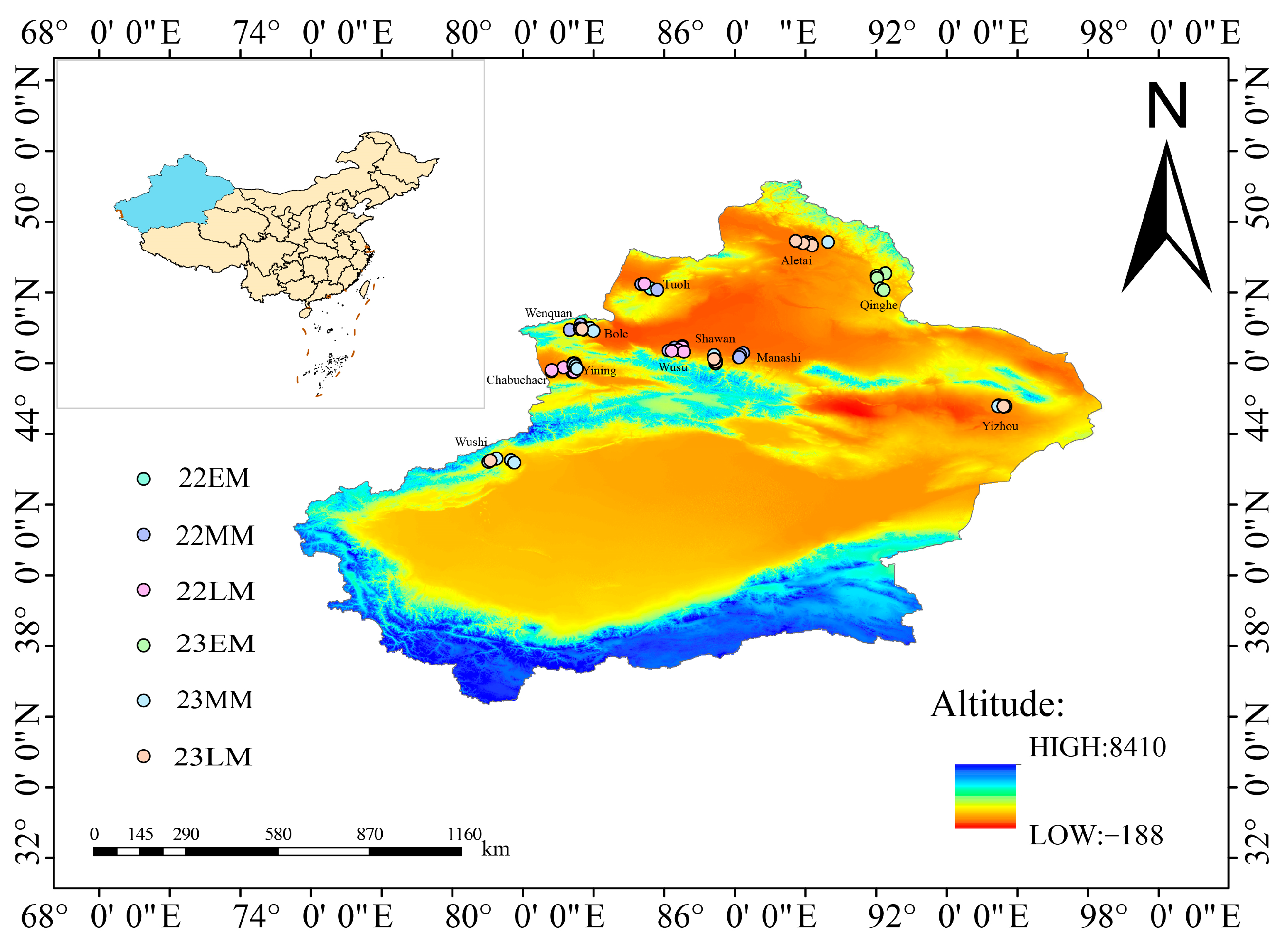
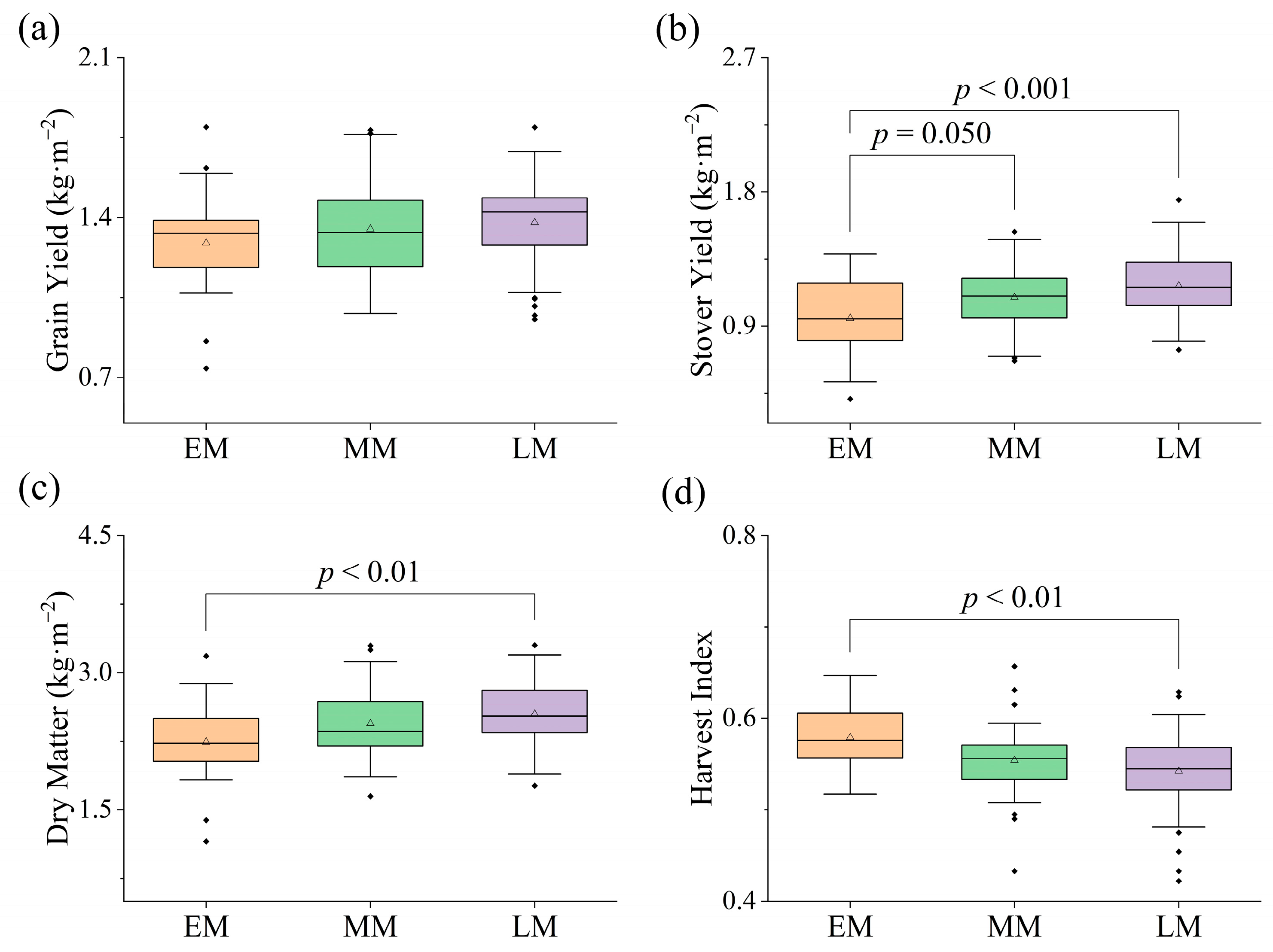
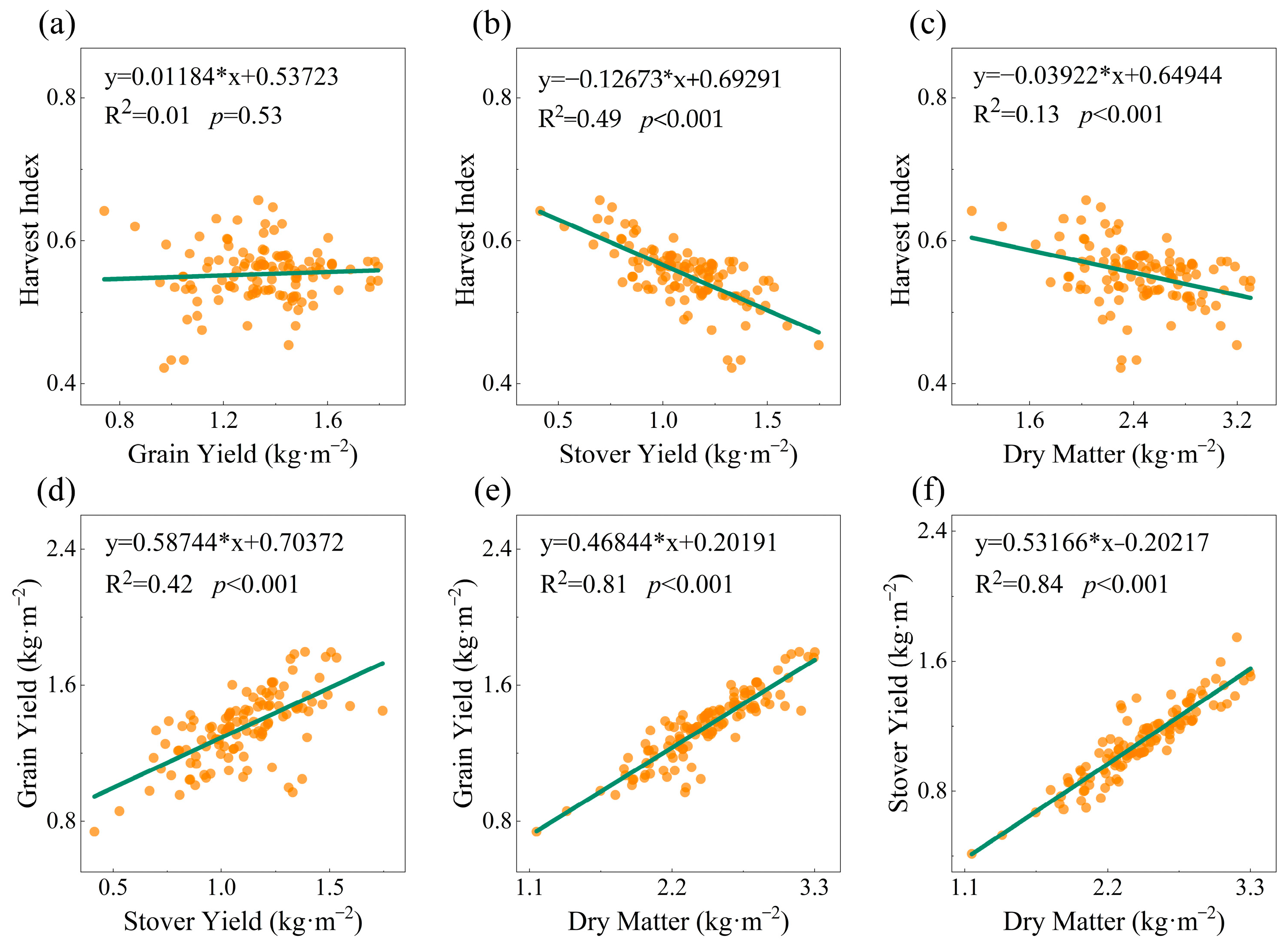

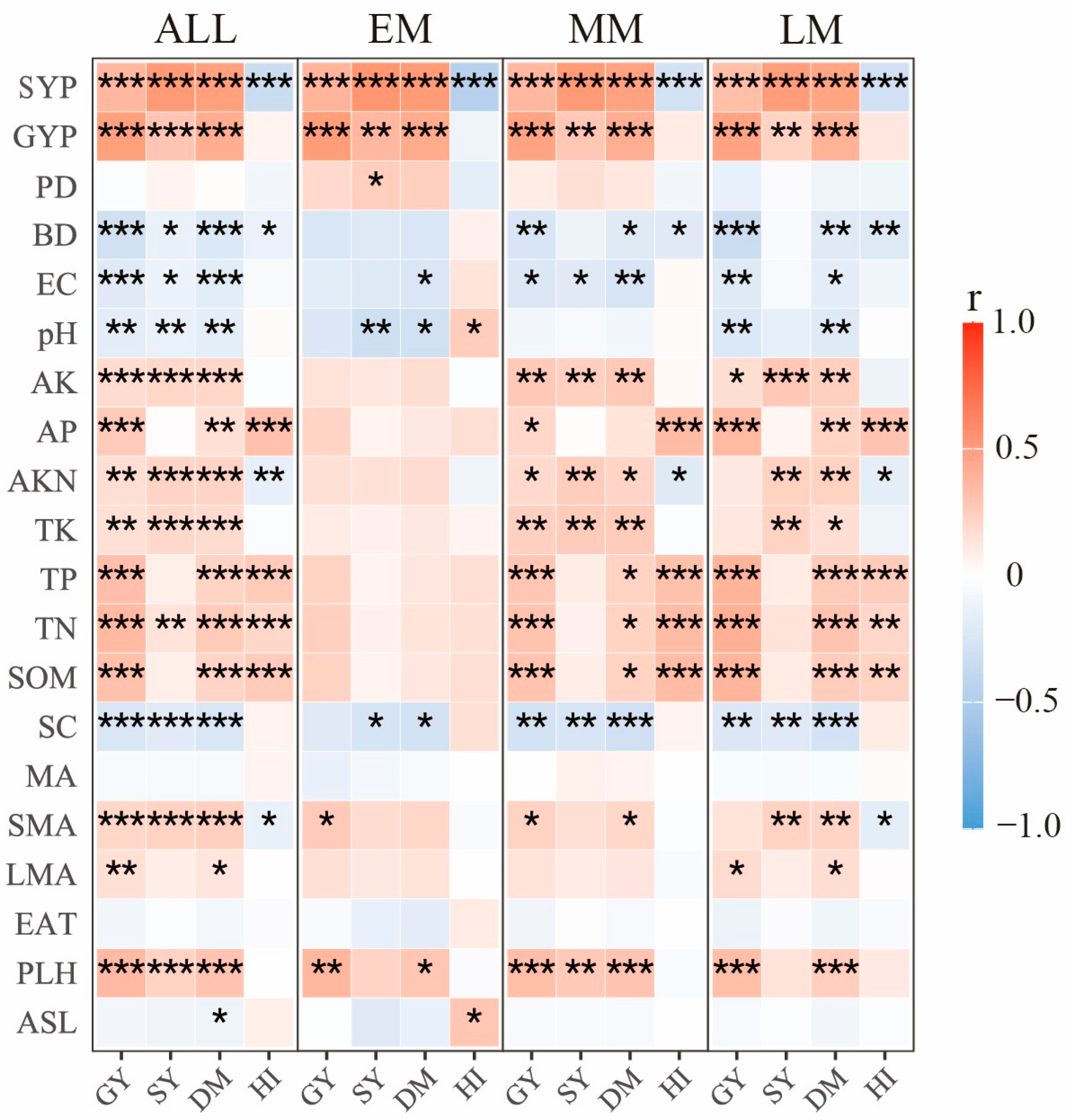
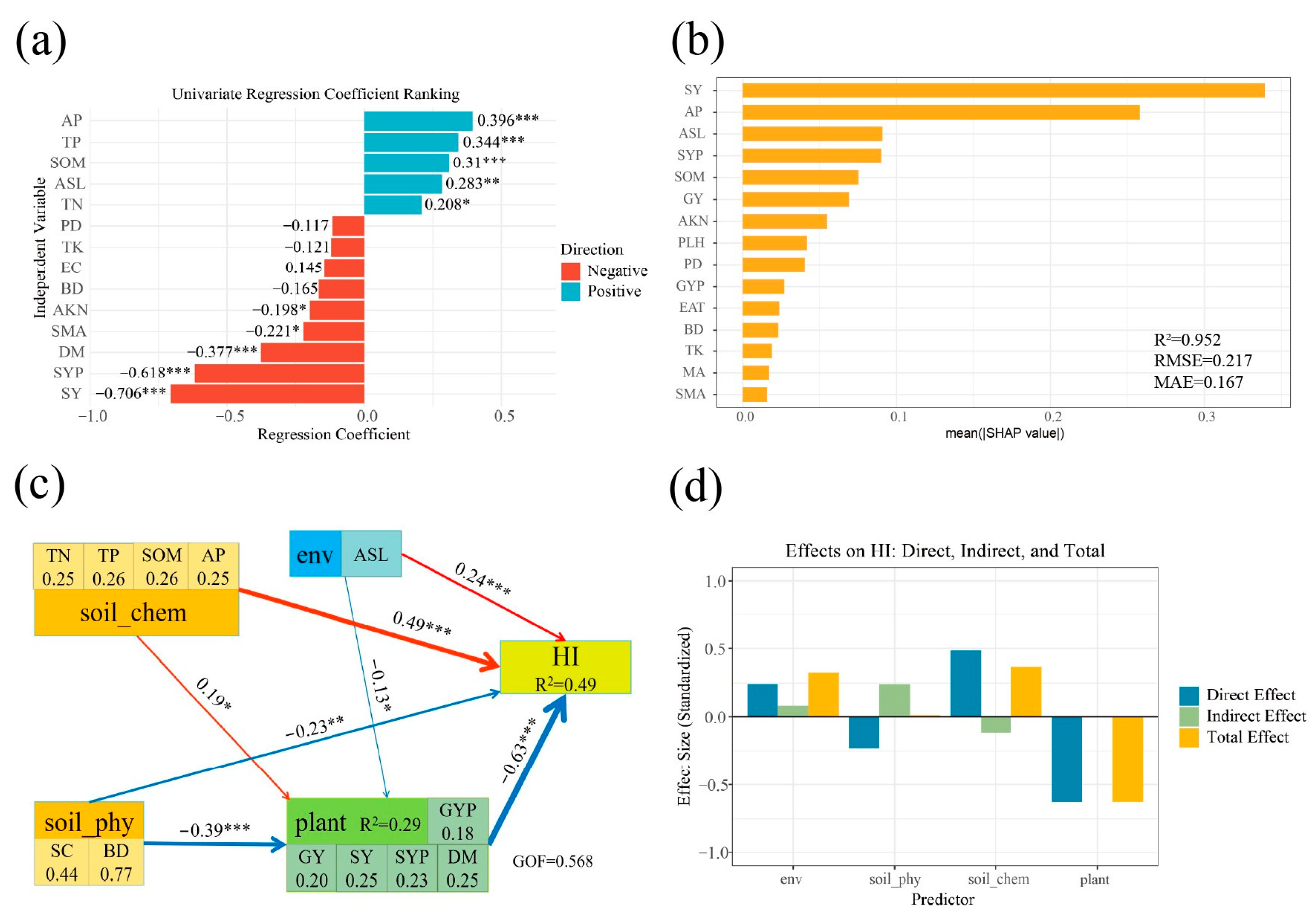

| Variable Grouping | Variable Name | Unit | Abbreviation | Average Value | Minimum | Maximum | Coefficient of Variation | Number of Cases |
|---|---|---|---|---|---|---|---|---|
| genetic factors | early-maturing | EM | 22 | |||||
| medium-maturing | MM | 40 | ||||||
| late-maturing | LM | 54 | ||||||
| agronomic practices | planting density | plants·m−2 | PD | 8.76 | 7.26 | 10.73 | 9.3% | 116 |
| climatic and geographic conditions | altitude | m | ASL | 798.59 | 452.00 | 1535.00 | 33.3% | |
| effective accumulated temperature | °C | EAT | 1909.27 | 1113.20 | 2413.50 | 22.8% | ||
| soil chemical properties | soil organic matter | g·kg−1 | SOM | 13.38 | 5.63 | 22.61 | 27.9% | |
| total nitrogen | TN | 1.07 | 0.34 | 2.38 | 41.1% | |||
| total phosphorus | TP | 0.91 | 0.20 | 1.75 | 41.7% | |||
| total potassium | TK | 24.79 | 14.44 | 40.88 | 24.6% | |||
| alkali-hydrolyzable Nitrogen | mg·kg−1 | AKN | 67.02 | 23.04 | 117.99 | 26.9% | ||
| available phosphorus | AP | 14.97 | 3.63 | 28.99 | 44.7% | |||
| available potassium | AK | 301.00 | 113.52 | 530.84 | 30.7% | |||
| pH | pH | 7.72 | 7.20 | 8.30 | 2.9% | |||
| soil physical properties | bulk density | g·cm−3 | BD | 1.16 | 0.75 | 1.72 | 17.3% | |
| electrical conductivity | mS·cm−1 | EC | 0.65 | 0.25 | 1.35 | 36.7% | ||
| large macroaggregates | % | LMA | 11.61 | −1.09 | 24.88 | 45.5% | ||
| small macroaggregates | SMA | 29.32 | 16.55 | 42.21 | 21.0% | |||
| microaggregates | MA | 30.73 | 13.52 | 49.08 | 19.4% | |||
| silt–clay fraction | SC | 28.34 | 8.23 | 59.60 | 28.2% | |||
| productivity parameters | grain yield | kg·m−2 | GY | 1.35 | 0.74 | 1.80 | 15.3% | |
| stover yield | SY | 1.10 | 0.41 | 1.75 | 20.9% | |||
| dry matter | DM | 2.45 | 1.15 | 3.30 | 16.2% | |||
| grain yield per plant | GYP | 0.16 | 0.09 | 0.21 | 17.9% | |||
| stover yield per plant | SYP | 0.13 | 0.05 | 0.21 | 22.7% | |||
| plant height | cm | PLH | 260.43 | 192.90 | 381.20 | 13.5% | ||
| harvest index | HI | 0.55 | 0.42 | 0.66 | 7.5% | |||
Disclaimer/Publisher’s Note: The statements, opinions and data contained in all publications are solely those of the individual author(s) and contributor(s) and not of MDPI and/or the editor(s). MDPI and/or the editor(s) disclaim responsibility for any injury to people or property resulting from any ideas, methods, instructions or products referred to in the content. |
© 2025 by the authors. Licensee MDPI, Basel, Switzerland. This article is an open access article distributed under the terms and conditions of the Creative Commons Attribution (CC BY) license (https://creativecommons.org/licenses/by/4.0/).
Share and Cite
Huo, Z.; Wutanbieke, H.; Chen, J.; Zhong, D.; Chen, Y.; Song, Z.; Lv, X.; Dong, H. Soil Phosphorus Content, Organic Matter, and Elevation Are Key Determinants of Maize Harvest Index in Arid Regions. Agriculture 2025, 15, 1207. https://doi.org/10.3390/agriculture15111207
Huo Z, Wutanbieke H, Chen J, Zhong D, Chen Y, Song Z, Lv X, Dong H. Soil Phosphorus Content, Organic Matter, and Elevation Are Key Determinants of Maize Harvest Index in Arid Regions. Agriculture. 2025; 15(11):1207. https://doi.org/10.3390/agriculture15111207
Chicago/Turabian StyleHuo, Zhen, Hengbati Wutanbieke, Jian Chen, Dongdong Zhong, Yongyu Chen, Zhanli Song, Xinhua Lv, and Hegan Dong. 2025. "Soil Phosphorus Content, Organic Matter, and Elevation Are Key Determinants of Maize Harvest Index in Arid Regions" Agriculture 15, no. 11: 1207. https://doi.org/10.3390/agriculture15111207
APA StyleHuo, Z., Wutanbieke, H., Chen, J., Zhong, D., Chen, Y., Song, Z., Lv, X., & Dong, H. (2025). Soil Phosphorus Content, Organic Matter, and Elevation Are Key Determinants of Maize Harvest Index in Arid Regions. Agriculture, 15(11), 1207. https://doi.org/10.3390/agriculture15111207






